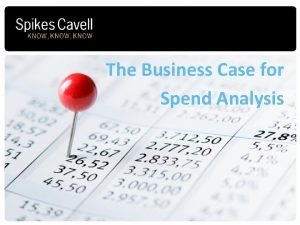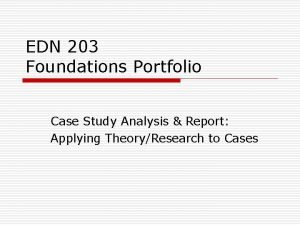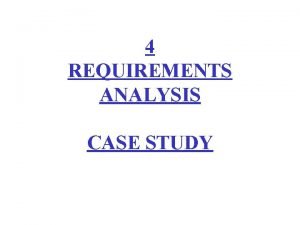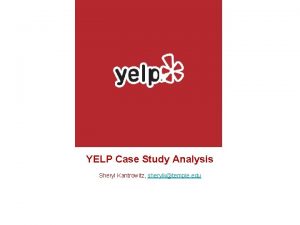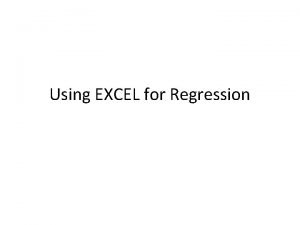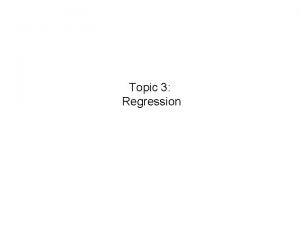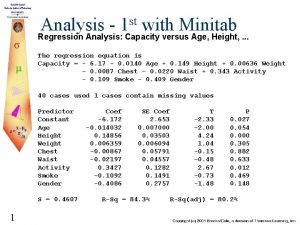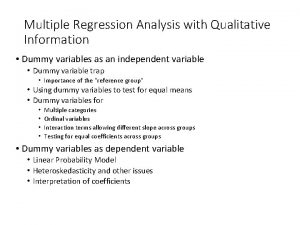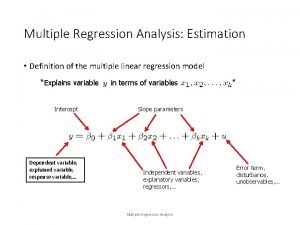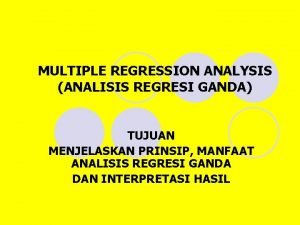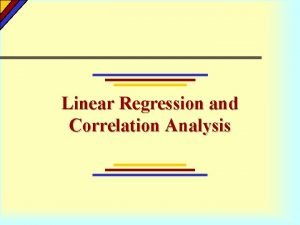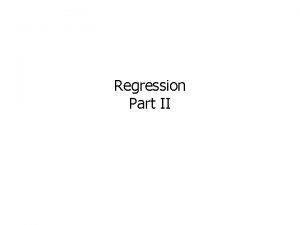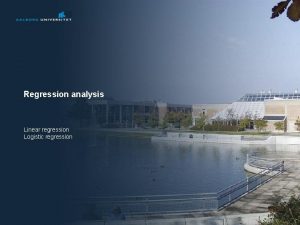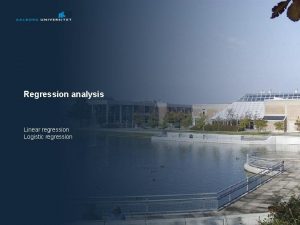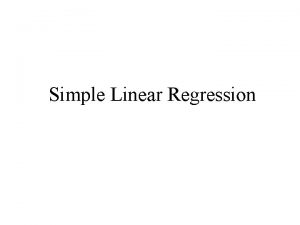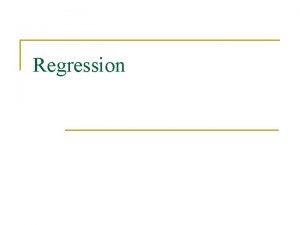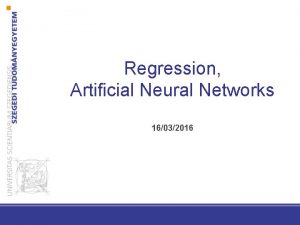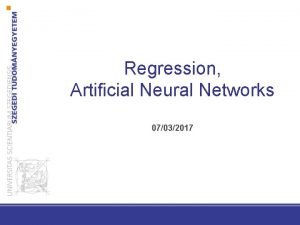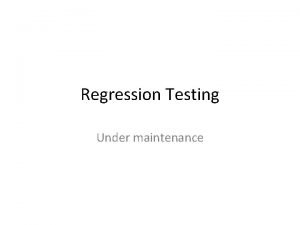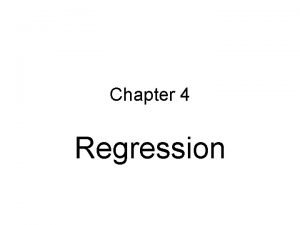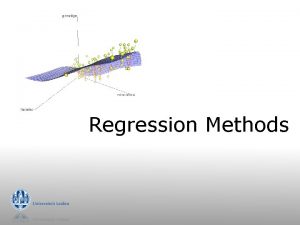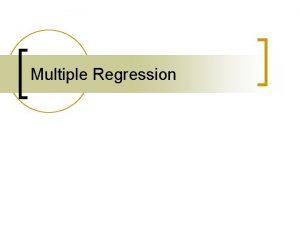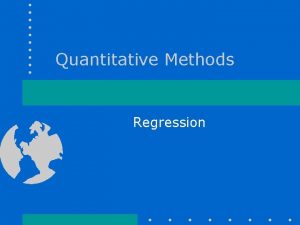Intervention Study Kenya PRIMR Case Regression Analysis March






















- Slides: 22

Intervention Study: Kenya PRIMR Case Regression Analysis March 2017 Susan Edwards, RTI International Sarrynna Sou, RTI International 1 RTI International is a registered trademark and a trade name of Research Triangle Institute. www. rti. org

Overview § Linear Regression – Replicating T-Test Analysis – Replicating Di. D Analysis – Controlling for Other Variables § § Logistic Regression – STATA Code: Similar to Linear Regression – Controlling for Other Variables § 2 Interpreting Estimates Interpreting Odds Ratios

Linear Regression Analysis § 3

Linear Regression Analysis - Example § 4

Linear Regression Analysis – Reference Cell Coding § Recall: § Interpretations: – § orf = 75 + 2. 7 I(female) – 3. 7 (age) This model suggests that girls read on average 2. 7 words per minute more than boys when controlling for student age. Reference Cell Coding: One level of a categorical variable is determined to be the reference. – All other estimates are presented in comparison to the reference. – § Example: – Female § 5 2 levels 0 = Male 1 = Female 2. 7 I(female) = the # of wpm difference between males and females

Linear Regression Analysis – Reference Cell Coding § Example with More than 2 Levels: – Age Category 3 levels 0 = Younger than Grade Level § 1 = At Grade Level § 2 = Older than Grade Level § – = Below 7 = 7 or 8 = Above 8 Model for ORF: ORF = 50 + 0. 2 I(At Grade Level) + -13 I(Older than Grade Level) – Questions: What is the average fluency for students in public schools? § What is the average fluency for students in private schools? § Do students in public schools preform better on average than students in religious schools? § Do students in private schools preform better on average than students in religious schools? § 6

Categorical vs. Continuous Independent Variables Why do we care? Categorical § Definition: – § STATA cares. Continuous § Definition: A variable that can be divided into distinct categories. Examples: – § gender – age category – STATA code: – Start variables with “i. ” followed by variable name i. <variable name> Reference Cell Coding 7 Examples: orf – age – Reading comprehension score? – § A variable that theoretically could go on forever § § Generally ranges from 0 to 5. STATA code: – List variable name in equation line.

Linear Regression Analysis – STATA Example § 8

Linear Regression Analysis – STATA Activity § Recall: STATA code to fit a model for gender and age. svy: reg eq_orf i. female age § Fit a linear model for English fluency (eq_orf) that accounts for the following school factors (nonformal; enrolment) svy: reg eq_orf i. nonformal enrolment Why does nonformal have an “i. ” in front of the variable name? – What type of variable is enrolment in this model? – How would we change enrolment to be a categorical variable? – Would the model work if we typed the following? – § 9 svy: reg enrolment i. nonformal eq_orf

T-Test Results with Linear Regression in STATA § Recall: T-Tests compare the means of two groups. § Example: ttest eq_orf, by (treat_phase) Is there a different between baseline and endline scores? Mean (N) § October 2013 48 wpm (913) 53 wpm (922) Difference (S. E. ) 4. 4 wpm (1. 7) T-Stat (DOF) 2. 59 (1833) H 0: = ; Ha: != P-Value = 0. 0095; Reject H 0 How can we use Linear Regression to duplicate these results? 10 October 2012

T-Test Results with Linear Regression in STATA Recall: ttest eq_orf, by (treat_phase) How can we use Linear Regression to duplicate these results? – How many variables are in used in the ttest command? § eq_orf § treat_phase Use a linear regression model that only contains the two variables of interest. What would the STATA code for the model look like? 11 reg eq_orf i. treat_phase

T-Test Results with Linear Regression in STATA Recall: ttest eq_orf, by (treat_phase) reg eq_orf i. treat_phase Mean (N) 12 October 2013 48 wpm (913) 53 wpm (922) Difference (S. E. ) 4. 4 wpm (1. 7) T-Stat (DOF) 2. 59 (1833) H 0: = ; Ha: != P-Value = 0. 0095; Reject H 0

T-Test Results with Linear Regression in STATA Recall: ttest eq_orf, by (treat_phase) reg eq_orf i. treat_phase October 2012 October 2013. ! d e ait t h W g i e w(913) Mean (N) 48 ewpm 53 wpm (922) n u r a s t l u s he t e r t c e e s Difference (S. E. ) 4. 4 wpm (1. 7) l ef r The s t l u s e r r ? u e l o p e T-Stat (DOF) 2. 59 (1833) k m a s ma e e h t w t n o a n c n w e H 0 o = ; Ha: != tio P-Value = 0. 0095; Reject s HH 0: a l a u h p p _ po t a e r t. i f or _ q e g e r : svy 13

Linear Regression in STATA – Controlling for Other Variables Want to Know: Effect of certain variables when other variables we know to be influential are controlled. Recall: orf = 75 + 2. 7 I(female) – 3. 7 (age) In this model, we may already know that older students are less fluent readers because they are repeating the grade or have taken a long break between school years. But we want to know if gender influences fluency once age is controlled. § When do we use models with multiple variables? – § Determine Demographic and SSME Impact What variables must be in these models? Variables that we know strongly influence the outcome. – Sample design variables – § 14 Treatment; Gender; Time

Linear Regression in STATA – Controlling for Other Variables - Example § Fit a model for English fluency that accounts for treatment, time, gender, and formal/nonformal school type. Question of Interest: Once design variables are controlled for, is there a difference between students in formal and nonformal schools? STATA Code: svy: reg eq_orf i. treatment i. treat_phase i. treatment#i. treat_phase i. female i. nonformal Interpretation: Students in nonformal schools read on average 29 wpm more than students in formal schools when study design is controlled. 15

Linear Regression in STATA – Controlling for Other Variables - Activity: – Determine if any of the other SSME variables make a difference on student English reading fluency (eq_orf). 16

Linear vs Logistic Regression § When would you want to use logistic regression? – Used to. . Model Binomial Categorical Data Examples: Zero Scores 0 = Score above Zero on Task 1 = Score equal Zero on Task § Reading Comprehension of 80% or Better 0 = Reading Comprehension Score < 80% 1 = Reading Comprehension Score >= 80% § – 17 Estimates. . . Probabilities and Odds Ratios

Linear vs Logistic Regression § 18

Linear vs Logistic Regression – Covariates & Odds Ratios § Covariates. . . § Example: Connected to Odds Ratios Reading Comprehension 80%+ = -3 + 0. 76 I(Has English Book) § Odds Ratio: – § English Book vs. No English Book = exp(0. 76) = 2. 14 Interpretation: – On average students with English books will be 2 times more likely than students without English books to comprehend at least 80% of a connected text. 19

Linear vs Logistic Regression – Covariates & Probabilities § 20

Logistic Regression Analysis – STATA Example Recall: Reading Comprehension 80%+ = -3 + 0. 76 I(Has English Book) NOTE: code is very similar to linear regression STATA Code: svy: logistic eq_read_comp_score_pcnt 80 i. e_book, coef Why does e_book have an “i. ” in front of the variable name? – Why doesn’t eq_read_comp_score_pcnt 80 have an “i. ”? – – 21 What is the difference between the two lines of code?

More Information Susan Edwards Research Statistician 919. 316. 3541 SEdwards@RTI. org Sarrynna Sou Statistician 919. 485. 2722 SSou@RTI. org
 Poland national anthem lyrics
Poland national anthem lyrics Linear regression vs multiple regression
Linear regression vs multiple regression Multiple regression
Multiple regression Logistic regression vs linear regression
Logistic regression vs linear regression Logistic regression vs linear regression
Logistic regression vs linear regression Best case worst case average case
Best case worst case average case It project failure case study
It project failure case study 6-5 rhombi and squares
6-5 rhombi and squares 11-1 areas of parallelograms
11-1 areas of parallelograms Attwirless
Attwirless Vodafone case study analysis
Vodafone case study analysis Case study business analysis
Case study business analysis Portfolio analysis case study
Portfolio analysis case study Diagram studied in requirement analysis
Diagram studied in requirement analysis Yelp case study analysis
Yelp case study analysis Simple linear regression excel
Simple linear regression excel Limitations of regression analysis
Limitations of regression analysis Stepwise regression minitab
Stepwise regression minitab Hierarchical regression analysis
Hierarchical regression analysis Multiple regression analysis with qualitative information
Multiple regression analysis with qualitative information Multiple regression analysis estimation
Multiple regression analysis estimation Multiple regression analysis adalah
Multiple regression analysis adalah Linear regression example
Linear regression example









